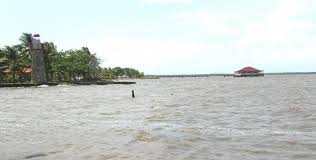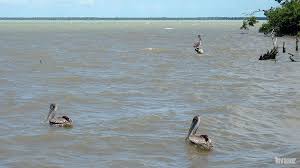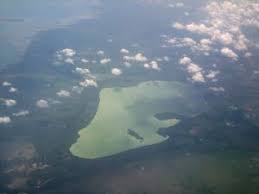CUBA DESCONOCIDA: “LA LAGUNA DE LA LECHE”, MORON, EL LAGO NATURAL MAS GRANDE DEL PAIS. PHOTOS
La “Laguna de la Leche”, también llamada Laguna Grande de Morón es el lago natural de agua dulce más grande de Cuba.
Está ubicado en el humedal del norte de la provincia de Ciego de Ávila, a 5 km (3,1 millas) al norte de Morón, y tiene una superficie total de 67,2 kilómetros cuadrados (25,9 millas cuadradas). (El embalse artificial de Zaza, con 113,5 km2 (43,8 millas cuadradas), es la superficie de agua continental más grande por área del país).
Porque este nombre tan peculiar de Laguna de la Leche a la mayor albufera de Cuba, ubicada a unos 470 kilómetros al Este de La Habana, antesala de los Jardines del Rey también nombrado Archipiélago Sabana-Camagüey.
En el municipio de Morón, provincia de Ciego de Ávila, radica el gran embalse natural que desde un avión asemeja un gigantesco grano de frijol blanco, bordeado por una exuberante vegetación de mangles de un verde intenso.
Acumula unos 100 millones de metros cúbicos de agua dulce y el contenidos de yeso y caliza en su fondo le dan ese color blanquecino, vertidas por un río desde el domo de Cunagua al Este y la caliza de las elevaciones de la Isla de Turiguanó por el Norte, topografía que rompen con el paisaje común de esta provincia, caracterizada por extensas llanuras
En la llamada boca de la laguna un pequeño faro sirve además de atalaya insuficiente para abarcar la blanca superficie de unos 67 kilómetros cuadrados.
FLORA Y FAUNA DE LA LAGUNA DE LA LECHE
Especies como la tilapia, las carpas y tempas, han desplazados a las truchas, biajacas, anguilas, sábalos, pataos y manjúas, antiguos dueños de los fondos y las aguas de la laguna.
También han desaparecido de su entorno los jabalies, puercos jíbaros y venados, aunque se mantienen visibles, gaviotas, flamencos, corúas, patos, yaguasas y distintos tipos de aves migratorias que hacen escala en la laguna luego de largos recorridos
Especialistas pesqueros consideran que de explotarse con métodos modernos de captura se podrían obtener gran cantidad de pescados anualmente.
Un lugar que puede ser habilitado para la práctica de yatismo y otros tipos de deportes náuticos, la Laguna de la Leche se ha visto afectada por el cambio climático en los último años.
Durante la intensa sequía de pasados años, el contorno de la superficie del embalse natural perdió de 70 a 50 metros en sus orillas, ante un gradual descenso del manto freático y con las intensas lluvias del huracán Irma y las grandes precipitaciones primaverales, provocan el desborde de sus márgenes en algunos puntos.
Especialistas del sistema costero incrementan la siembra de mangles en sus contornos y aplican técnicas para el saneamiento de sus aguas con el objetivo de conservar la Laguna de la Leche como la mayor albufera cubana.
UNKNOWN CUBA: “THE MILK LAGOON”, MORON, THE LARGEST NATURAL LAKE IN THE COUNTRY. PHOTOS
The “Laguna de la Leche”, also called Laguna Grande de Morón, is the largest natural freshwater lake in Cuba.
It is located in the northern wetland of the province of Ciego de Ávila, 5 km (3.1 mi) north of Morón, and has a total area of 67.2 square kilometers (25.9 sq mi). (The artificial Zaza reservoir, at 113.5 km2 (43.8 sq mi), is the largest inland water surface by area in the country.)
Because this very peculiar name of Laguna de la Leche is the largest lagoon in Cuba, located about 470 kilometers east of Havana, anteroom of the Jardines del Rey also named Sabana-Camagüey Archipelago.
In the municipality of Morón, province of Ciego de Ávila, lies the large natural reservoir that from an airplane resembles a gigantic grain of white beans, bordered by exuberant vegetation of intense green mangroves.
It accumulates about 100 million cubic meters of fresh water and the gypsum and limestone content at its bottom gives it that whitish color, poured by a river from the Cunagua dome to the east and the limestone from the elevations of Turiguanó Island to the east. North, topography that breaks with the common landscape of this province, characterized by extensive plains
At the so-called mouth of the lagoon, a small lighthouse also serves as a watchtower, insufficient to cover the white surface of about 67 square kilometers.
FLORA AND FAUNA OF LAGUNA DE LA LECHE
Species such as tilapia, carp and tempas have displaced trout, biajacas, eels, shad, pataos and manjúas, former owners of the bottoms and waters of the lagoon.
Wild boars, wild pigs and deer have also disappeared from their surroundings, although seagulls, flamingos, corúas, ducks, yaguasas and different types of migratory birds that stop at the lagoon after long journeys remain visible.
Fisheries specialists consider that if exploited with modern capture methods, a large amount of fish could be obtained annually.
A place that can be enabled for the practice of yachting and other types of water sports, Laguna de la Leche has been affected by climate change in recent years.
During the intense drought of past years, the contour of the surface of the natural reservoir lost 70 to 50 meters on its banks, due to a gradual decrease in the water table and with the intense rains of Hurricane Irma and the large spring rainfall, causing the overflow. of its margins in some points.
Specialists of the coastal system increase the planting of mangroves in its contours and apply techniques for the sanitation of its waters with the aim of preserving the Laguna de la Leche as the largest Cuban lagoon.
Agencies/ Wiki/ Radio Habana/ Walfredo Angulo/ Pedro M.Otero/ Internet Photos/ Arnoldo Varona/ www.TheCubanHistory.com
THE CUBAN HISTORY, HOLLYWOOD.









